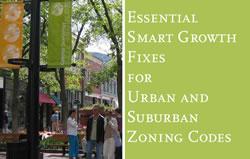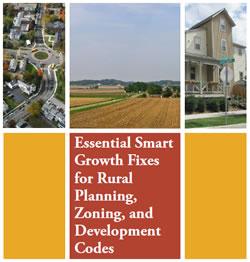- Essential Smart Growth Fixes for Urban and Suburban Zoning Codes
- Essential Smart Growth Fixes for Rural Planning, Zoning, and Development Codes
Essential Smart Growth Fixes for Urban and Suburban Zoning Codes

Across the country, local governments are trying to create vibrant communities that attract jobs, foster economic development, and are attractive places for people to live, work, and play. But many are discovering that their land development codes and ordinances often get in the way of achieving these goals, and they might not have the resources or expertise to make the specific regulatory changes that will create more sustainable communities.
To respond to this need, EPA convened a panel of national smart growth code experts to identify local zoning code topics that are essential to creating the building blocks of smart growth. Essential Smart Growth Fixes for Urban and Suburban Zoning Codes (2009) presents the panel's work. It is intended to spark a conversation about the tools and information local governments need to revise their land development regulations.
Eleven "essential fixes" address the most common barriers local governments face in implementing smart growth strategies. Topics include mixing land uses, changing parking requirements, modernizing street standards, managing stormwater, and adopting smart annexation policies.
Each essential fix describes a problem or barrier and the actions the community could take to overcome it. These actions are grouped together as modest adjustments, major modifications, or wholesale changes to give communities options based on their political will, financial resources, and organizational capacity. Communities can apply multiple fixes, implement parts of fixes, or overhaul their codes entirely.
This document does not include model language, and it is not intended to provide model codes or ordinances. (Specific examples of codes that support smart growth development can be found on our Codes That Support Smart Growth Development page.) This tool can help communities evaluate existing codes and ordinances and apply the information to create more environmentally, economically, and socially sustainable communities.

Essential Smart Growth Fixes for Rural Planning, Zoning, and Development Codes
Essential Smart Growth Fixes for Rural Planning, Zoning, and Development Codes (2012) provides policy options that can help rural communities strengthen their economies while preserving rural character. These policies can help rural communities ensure that their development is fiscally sound, environmentally responsible, and socially equitable. Topics include fiscal impact analysis, commercial development, wastewater infrastructure, rural roads, and efficient development patterns.
Many rural communities are trying to maintain their rural character while strengthening their economies. Slow-growing and shrinking rural areas are finding that their policies are not resulting in the prosperity they seek; fast-growing rural areas at the edge of metropolitan regions face metropolitan-style development pressures and want to manage their growth in ways that promote prosperity and are environmentally sustainable.
As with the Essential Smart Growth Fixes for Urban and Suburban Zoning Codes, this publication does not present model codes or a recipe for implementing particular policies. Instead, it provides a range of ideas from modest adjustments to wholesale changes. Each community can determine the options that best fit its needs.
Rural communities have many strategies at their disposal to determine where and how growth happens; this publication looks only at land use strategies and not at the full toolbox. For more information on rural smart growth development, including other strategies and tools, see Putting Smart Growth to Work in Rural Communities, a publication developed by EPA and the International City/County Management Association (ICMA).
Find more resources on smart growth in small towns and rural communities.
You may need a PDF reader to view some of the files on this page. See EPA’s About PDF page to learn more.